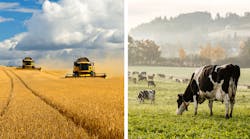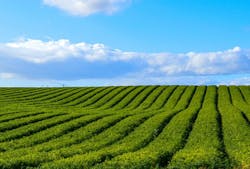According to a recent article, the farming industry is on the verge of a major shake-up in what’s being referred to as “Agriculture 4.0.” A forecast drawn up by the Institute of Biological, Environmental, and Rural Sciences (IBERS) reports it “[envisions] a future where farmers use mobile command centers to oversee robots, power plants, and closed-loop recycling systems.” Imagine if mobile phones were able to control farms.
The Internet of Things is sparking a revolution within the farming community, on a scale that’s being compared to the industry’s 20th Century mechanization. This change in technology is being heralded as a net positive for society and progressive farmers, affecting global health, food production, and climate change for the better.
“This raft of technologies could have a hugely positive effect on rural livelihoods, economies, and the ability of the food supply chain to tackle the grand challenges of our age,'” says IBERS.
IoT doesn’t stop with cows. Many farmers are using IoT devices to track ambient conditions in the air water and soil to manage resources such as pesticides and watering practices.
Agriculture 4.0 is set to bring information technology to the farm and create a food supply chain that’s even more connected. So what are some of the changes we’re already starting to see automate the way farmers do things?
Rethinking RFID
Radio Frequency Identification (RFID) or Electronic Identification (EID) tags certainly aren’t new technology. However, these tags may soon be the main way farmers track and identify stock, automating the collection of data and information out in the field.
Tagging allows animals to be identified, located, and tracked using radio frequency signals. Over a period of time, for example, an animal’s weight history can be traced back as either “good” or “bad” and, from there, resources can be reallocated in order to maximize livestock health and profits.
RFID tags and wand readers have already proven to be an effective way to track animals in New Zealand after passing the National Animal Identification and Tracing (NAIT) Act of 2012. In addition, this technology removes human error from the equation that may occur when recording stock numbers. RFID tags are still readable even when covered in dirt and excrement, providing a safe distance in which to be working around stock as the tags can be read from a distance of about 11 to 35 inches (30-90cm).
Radio-frequency identification using electromagnetic fields to automatically identify and track tags attached to objects.
Depending on the RFID reader, these can range anywhere from $350-$3,500. Most RFID taggers come with a mobile app that allows farmers to send data directly to NAIT, bringing the tracking full-circle and saving time on documentation. In fact, many companies already incorporate NAIT functionality into their farming management tools, such as weigh scale software, allowing more effective animal management.
It’s not only milking cows which will benefit from this technology. This could also be useful for deer and pig farms through the recording of weight, treatments, milk production, and breeding information. To name just a few!
Cow-sidering Conditions
Weighing your herd twice a day when cows exit after milking provides a more accurate reading by averaging the results and graphing changes in body weight for each cow. Documenting and graphing this data creates a trendline that can be easily tracked and read so workers can react to changes quickly.
Modern innovations in scales provide weight for each cow, and are able to balance weight trends with the stage of lactation, milk yield, and daily feed allocation. Combining milk and animal weight data is essential for optimizing animal health and spotting changes in body condition.
More Than What “Meats” the Eye
Thermal imaging (TI) isn’t a new concept either, however: It’s finding a new place on the farm. What if this meant you could detect injuries and disease before these become apparent to the naked eye? What if you could easily find stray lambs or calves in even the most treacherous or darkest of conditions with thermal imaging?
Additionally, this technology could alter the way animals are treated. Identifying and treating certain injuries and ailments are made easier with thermal imaging, which could potentially save on vet bills, cut antibiotic use, and ultimately save lives.
Following cows around a field can be difficult. However, you don’t necessarily need real-time data. Documenting weight and health when the cows are brought in to be milked will offer enough data to find trendlines and ensure productivity.
TI also provides a far safer method for checking on animals. If you’ve ever had to help an injured animal, you’ll know just how prone they are to kicking, biting, and doing most anything they can in order to protect themselves. With thermal imaging, you’ll be able to identify the problem from a safe distance without the need for a large supporting team. This could play a very important role in identifying early stages of mastitis, inflammation, and lameness.
TI works by creating real-time thermograms produced by infrared radiation from an object (or animal, in this case), and so far experiments are showing a high level of accuracy. “TI cameras have been used to successfully diagnose respiratory disease in calves a week before clinical symptoms arose!” reports the UK Daily Post. While TI is still in its early stages for animal use, it is already proving a successful technology for the farming industry.
Technology Takeover?
Whether “Agriculture 4.0” makes it to the finish line or not, or how quickly it arrives, it’s an exciting time for those within the industry. With technologies such as RFID and EID Tags, automated weighing, and thermal imaging technology, farmers are gaining much needed visibility, information, and feedback that can only mean better things for the health of their livestock and their bottom line.




